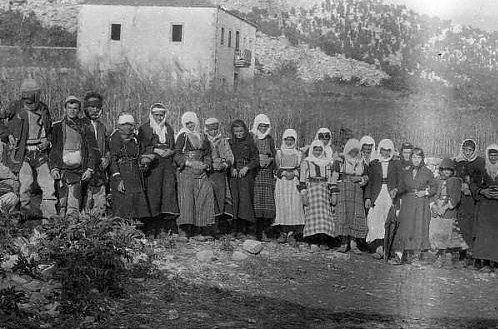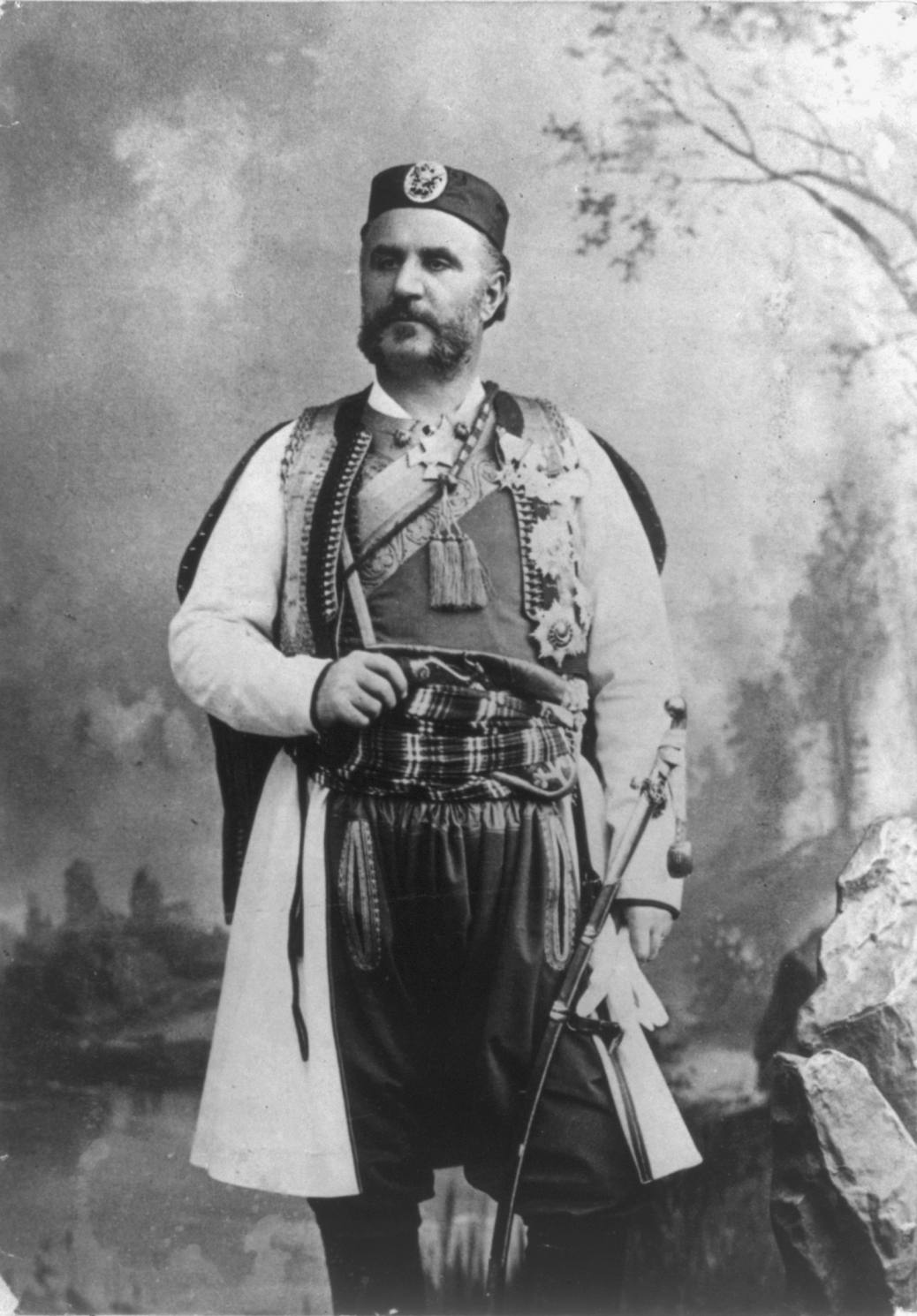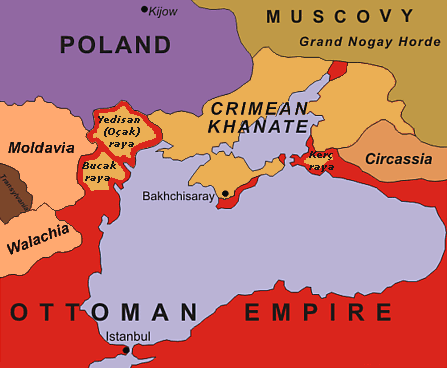|
Sokol Baci
Sokol Baci (1837–1920) was the chief of the Gruda, a northern Albanian tribe in the vicinity of Podgorica (now Montenegro). Originally, he had served the Ottoman sultan in his personal guard, but switched sides after he was mistreated, and fought the Ottoman forces in the Sanjak of Scutari. After his clan was defeated and subjugated, he was exiled and sought refuge in Montenegro, even though he had earlier fought against them in the 1870s, and lived in Podgorica beginning in approximately 1884. Prince Nicholas I of Montenegro recognized his status and employed him. He was one of the leaders of the Albanian Revolt of 1911, alongside chiefs such as Ded Gjo Luli, Mehmet Shpëndi, Mirash Luca and Luigj Gurakuqi. In 1912, the entire tribes of Gruda and Hoti, along with major portions of the Kastrati, Shkreli, and Kelmendi tribes, backed Montenegro during the Balkan Wars. In 1913, he was recognized as commander of Scutari by King Nicholas I of Montenegro. Life Early life S ... [...More Info...] [...Related Items...] OR: [Wikipedia] [Google] [Baidu] |
Gruda (tribe)
Gruda is a Northern Albanian tribe and historical tribal region in southeastern Montenegro, just north of Lake Skadar, which includes the small town of Tuzi, in Podgorica. It is inhabited by a majority of ethnic Albanians. Geography Gruda is an Albanian historical tribal region within Montenegro, along the mountainous border with Albania, east of Podgorica. It borders to the historical tribal regions of Hoti and Kelmendi to the south and east (in Southern Montenegro and Northern Albania), and Slavic regions to the north. The historical Gruda tribal region, as described by A. Jovićević (1923), include the following settlements: *Settlements on the right bank of Cemi : ** Dinoša / Dinoshë ** Lovka / Llofkë ** Pikalj / Pikalë ** Prifti / Prift ** Selišta / Selishtë *** Gornja Selišta / Selishtë e Epërme *** Donja Selišta / Selishtë e Poshtme *Settlements on the left bank of Cijevna: ** Gurec / Gurrec ** Kaljaj / Kalaj ** Krševo / Kshevë ** Milješ / Mi ... [...More Info...] [...Related Items...] OR: [Wikipedia] [Google] [Baidu] |
Shkreli (tribe)
Shkreli is a historical Albanian tribe and region in the Malësia Madhe region of Northern Albania and is majority Catholic. With the expansion of the Ottoman Empire, part of the tribe migrated to Rugova in Western Kosovo beginning around 1700, after which they continued to migrate into the Lower Pešter and Sandžak regions (today in Serbia and Montenegro). The Shkreli tribe that migrated to Kosovo converted to Islam in the 18th century and maintained the Albanian language as their mother tongue. Some members of the Shkreli within the Pešter region and in Sandžak (known as Škrijelj/ sr, Шкријељ) converted to Islam and became Slavophones by the 20th century, which as of today they now self-identify as part of the Bosniak ethnicity, although in the Pešter plateau they partly utilized the Albanian language until the middle of the 20th century. The Shkreli in Albania and Montenegro are predominantly Catholic. The Shkreli tribe's patron saint is St. Nicholas (Shënk ... [...More Info...] [...Related Items...] OR: [Wikipedia] [Google] [Baidu] |
Sokol Baci2
The Sokol movement (, ''falcon'') is an all-age gymnastics organization first founded in Prague in the Czech region of Austria-Hungary in 1862 by Miroslav Tyrš and Jindřich Fügner. It was based upon the principle of " a strong mind in a sound body". The Sokol, through lectures, discussions, and group outings provided what Tyrš viewed as physical, moral, and intellectual training for the nation. This training extended to men of all ages and classes, and eventually to women. The movement also spread across all the regions populated by Slavic cultures, most of them part of either Austria-Hungary or the Russian Empire: present-day Slovakia, the Slovene Lands, Croatia, Serbia ( SK Soko), Bulgaria, Poland (Sokół), Ukraine, Belarus. In many of these nations, the organization also served as an early precursor to the Scouting movements. Though officially an institution "above politics", the Sokol played an important part in the development of Czech nationalism and patriotism, whi ... [...More Info...] [...Related Items...] OR: [Wikipedia] [Google] [Baidu] |
Nicholas Of Montenegro
Nikola I Petrović-Njegoš ( sr-cyr, Никола I Петровић-Његош; – 1 March 1921) was the last monarch of Montenegro from 1860 to 1918, reigning as prince from 1860 to 1910 and as the country's first and only king from 1910 to 1918. Biography Early life Nikola was born in the village of Njeguši, the home of the reigning House of Petrović. He was the son of Mirko Petrović-Njegoš, a celebrated Montenegrin warrior (an elder brother to Danilo I of Montenegro) and his wife, Anastasija Martinovich (1824–1895). After 1696, when the dignity of vladika, or prince-bishop, became hereditary in the Petrović family, the sovereign power had descended from uncle to nephew, the vladikas belonging to the order of the black clergy (i.e., monastic clergy) who are forbidden to marry. A change was introduced by Danilo I, who declined the episcopal office, married and declared the principality hereditary in the direct male line. Mirko Petrović-Njegoš having renounced his clai ... [...More Info...] [...Related Items...] OR: [Wikipedia] [Google] [Baidu] |
Sokol Baci Ivezić
The Sokol movement (, ''falcon'') is an all-age gymnastics organization first founded in Prague in the Czech region of Austria-Hungary in 1862 by Miroslav Tyrš and Jindřich Fügner. It was based upon the principle of " a strong mind in a sound body". The Sokol, through lectures, discussions, and group outings provided what Tyrš viewed as physical, moral, and intellectual training for the nation. This training extended to men of all ages and classes, and eventually to women. The movement also spread across all the regions populated by Slavic cultures, most of them part of either Austria-Hungary or the Russian Empire: present-day Slovakia, the Slovene Lands, Croatia, Serbia ( SK Soko), Bulgaria, Poland (Sokół), Ukraine, Belarus. In many of these nations, the organization also served as an early precursor to the Scouting movements. Though officially an institution "above politics", the Sokol played an important part in the development of Czech nationalism and patriotism, whi ... [...More Info...] [...Related Items...] OR: [Wikipedia] [Google] [Baidu] |
Mašo Vrbica
Mašo Vrbica ( sr-Cyrl, Машо Врбица; 1833 in Vrba – 10 May 1898 in Banja Luka) was a Montenegrin '' vojvoda'' and military commander. Biography He graduated from the Mikhailovskaya Artillery Military Academy in St. Petersburg. After his return to Montenegro, he was appointed as a captain in the Njeguši militia, which was part of the Montenegrin army. He commanded a unit at the Battle of Grahovac in 1858, and with the cannon captured there organized the artillery for Montenegrin army. During the Montenegrin-Ottoman War of 1861-1862, he commanded the artillery. Between the wars he joined the nationalist "United Serbian Youth" where he met such men as Vladimir Jovanović, Svetozar Miletić, Nikola Pašić, Nikola Petrovic, Marko Popovic Miljanov, and Valtazar Bogišić. In 1875 Vrbica was given the title of '' vojvoda''. He was a liaison of Montenegro to the Serbian Supreme Command during the Serbo-Turkish War (1876–78), during which he commanded Montenegrin dra ... [...More Info...] [...Related Items...] OR: [Wikipedia] [Google] [Baidu] |
Montenegrin–Ottoman War (1876–78)
{{disambiguation ...
Montenegrin–Ottoman War may refer to: *Montenegrin–Ottoman War (1852–53) *Montenegrin–Ottoman War (1861–62) *Montenegrin–Ottoman War (1876–78) Montenegrin–Ottoman War may refer to: *Montenegrin–Ottoman War (1852–53) *Montenegrin–Ottoman War (1861–62) Montenegrin–Ottoman War may refer to: * Montenegrin–Ottoman War (1852–53) * Montenegrin–Ottoman War (1861–62) *Montenegri ... [...More Info...] [...Related Items...] OR: [Wikipedia] [Google] [Baidu] |
Principality Of Montenegro
The Principality of Montenegro ( sr, Књажевина Црна Горa, Knjaževina Crna Gora) was a principality in Southeastern Europe that existed from 13 March 1852 to 28 August 1910. It was then proclaimed a kingdom by Nikola I, who then became King of Montenegro. The capital was Cetinje and the Montenegrin perper was used as the state currency from 1906. The territory corresponded to the central area of modern-day Montenegro. It officially was a constitutional monarchy, but ''de facto'' was an absolute monarchy. Name In Danilo I's Code, dated to 1855, he explicitly states that he is the "''knjaz'' and ''gospodar'' of ''Crna Gora'' and '' Brda''" ( sr, / ; "prince and lord of Montenegro and Brda", "duke and lord of Montenegro and Brda"). In 1870, Nikola had the title of "''knjaz'' of ''Crna Gora'' and ''Brda''" (; "prince of Montenegro and Brda", "duke of Montenegro and Brda"), while two years later, the state was called "''Knjaževina'' of ''Crna Gora''" (; "Princi ... [...More Info...] [...Related Items...] OR: [Wikipedia] [Google] [Baidu] |
Zatrijebač
Trieshi is a historical Albanian tribe (''fis'') and region (in Montenegrin known as ''Zatrijebač'') in Montenegro above the right bank of the Cem river near the Albanian border in Tuzi Municipality. It is part of the region of Malësia. Geography Trieshi lies in the municipality of Tuzi on the Albania-Montenegro border as the Cem crosses into Montenegro after Grabom along the river's right bank. It has a total territory of about 30 km² and all of its settlements are in mountainous terrain with little arable land. The settlements of Trieshi are: Nikmarash, Rudinë, Muzheçk, Budëz, Poprat, Stjepoh, Delaj, Bëkaj, Llopar, Cem i Trieshit. In terms of historical territory, Trieshi borders Hoti to the south-west, Kelmendi to the east, Gruda to the west and Koja e Kuçit to the north. Origins Oral traditions and fragmentary stories were collected and interpreted by writers who travelled in the region in the 19th century about the early history of Trieshi. In the 20th century ... [...More Info...] [...Related Items...] OR: [Wikipedia] [Google] [Baidu] |
Russo-Turkish War (1877–78)
The Russo-Turkish wars (or Ottoman–Russian wars) were a series of twelve wars fought between the Russian Empire and the Ottoman Empire between the 16th and 20th centuries. It was one of the longest series of military conflicts in European history. Except for the war of 1710–11 and the Crimean War, which is often treated as a separate event, the conflicts ended disastrously for the Ottoman Empire; conversely, they showcased the ascendancy of Russia as a European power after the modernization efforts of Peter the Great in the early 18th century. History Conflict begins (1568–1739) Before Peter the Great The first Russo-Turkish War (1568–1570) occurred after the conquest of Kazan and Astrakhan by the Russian tsar Ivan the Terrible. The Ottoman sultan Selim II tried to squeeze the Russians out of the lower Volga by sending a military expedition to Astrakhan in 1569. The Turkish expedition ended in disaster for the Ottoman army, which could not take Astrakhan and a ... [...More Info...] [...Related Items...] OR: [Wikipedia] [Google] [Baidu] |








